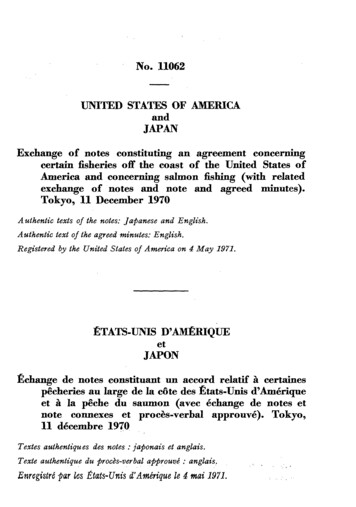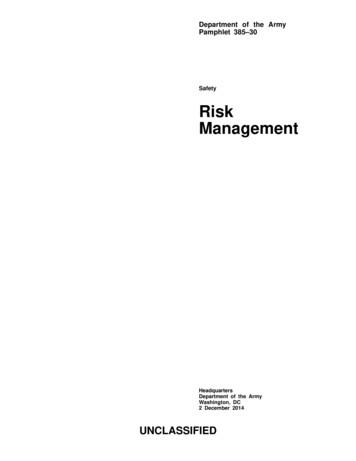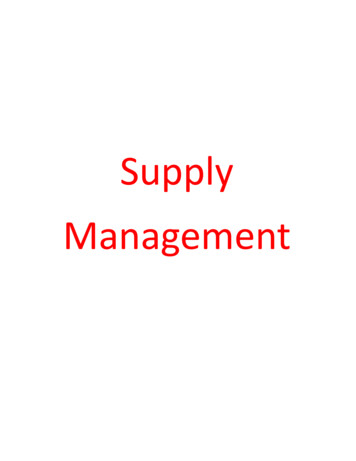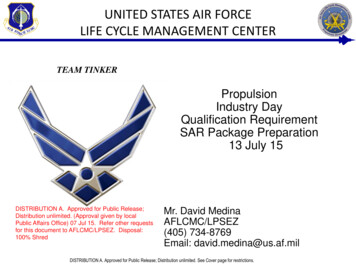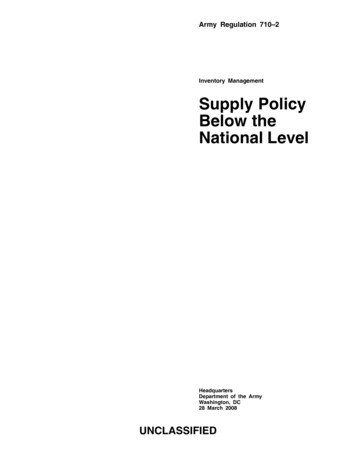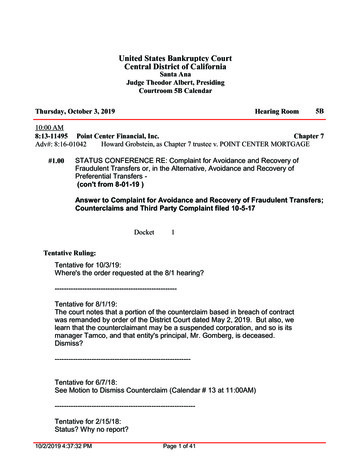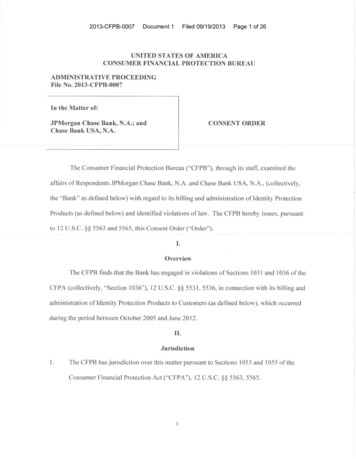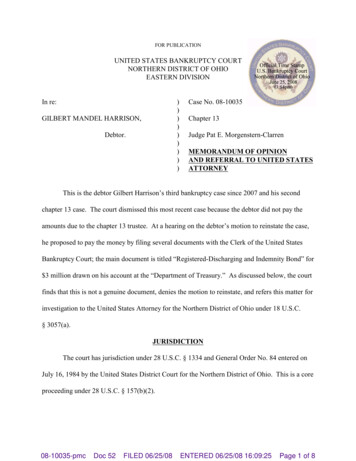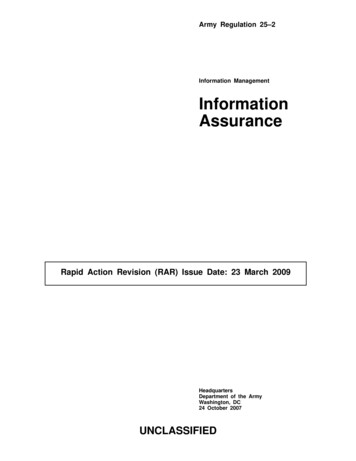
Transcription
Army Regulation 25–2Information ManagementInformationAssuranceRapid Action Revision (RAR) Issue Date: 23 March 2009HeadquartersDepartment of the ArmyWashington, DC24 October 2007UNCLASSIFIED
SUMMARY of CHANGEAR 25–2Information AssuranceThis rapid action revision, dated 23 March 2009-oClarifies and corrects references to Department of Defense Directive 8750.1and Army training requirements (para 4-3).oRemoves incorrect course reference to Information Assurance Manager Courseand provides correct information on Certified Information Systems SecurityProfessional modules (para 4-3).oRemoves incorrect information regarding Fort Gordon course topics (para 4-3).oRemoves references to the Asset and Vulnerability Tracking Resourcecompliance reporting database, which is no longer used, to correctlyreference the Army Training and Certification Tracking System (para 4-3).oDeletes incorrect reference to Skillport for required information assurancetraining (para 4-3).oChanges Department of Defense Warning Banner verbiage to comply withDepartment of Defense directed mandatory guidance (para 4-5).oCorrects references to the National Information Assurance Partnership (para6-1).oAdds mandatory Department of Defense Standardized Notice and Consent UserAgreement language (app B-3).oUpdates office symbols and acronyms (throughout).
*Army Regulation 25–2HeadquartersDepartment of the ArmyWashington, DC24 October 2007Effective 13 November 2007Information ManagementInformation AssuranceHistory. This publication is a rapid actionrevision (RAR). This RAR is effective 23April 2009. The portions affected by thisRAR are listed in the summary of change.Summary. This regulation provides Information Assurance policy, mandates,roles, responsibilities, and procedures forimplementing the Army Information Assurance Program, consistent with today’stechnological advancements for achievingacceptable levels of security in engineering, implementation, operation, and maintenance for information systemsconnecting to or crossing any U.S. Armymanaged network.Applicability. This regulation applies tothe Active Army, the Army NationalGuard/Army National Guard of the UnitedStates, and the U.S. Army Reserve, unlessotherwise stated. Also, it applies to allusers, information systems, and networksat all information classification levels;Contentsprogram executive officers; direct reporting program managers; strategic, tactical,and non-tactical environments or installations; internal or external organizations,services, tenants, or agencies (for example, DOD, sister Services, U.S. ArmyCorps of Engineers (USACE); contractorsworking on Army information systemspursuant to Army contracts; Army andAir Force Exchange Service (AAFES);morale, welfare, and recreation activities;educational institutions or departments(for example, DOD schools, the U.S. Military Academy at West Point); and Armyaffiliated or sponsored agencies (for example, Western Hemisphere Institute forSecurity Cooperation). During mobilization, the proponent may modify chaptersand policies contained in this regulation.Proponent and exception authority.The proponent of this regulation is theChief Information Officer/G–6. The proponent has the authority to approve exceptions or waivers to this regulation thatare consistent with controlling law andregulations. The proponent may delegatethis approval authority, in writing, to adivision chief within the proponentagency or its direct reporting unit or fieldoperating agency, in the grade of colonelor the civilian equivalent. Activities mayrequest a waiver to this regulation by providing justification that includes a fullanalysis of the expected benefits and mustinclude a formal review by the activity’ssenior legal officer. All waiver requestswill be endorsed by the commander orsenior leader of the requesting activityand forwarded through their higher headquarters to the policy proponent. Refer toAR 25–30 for specific guidance.Army management control process.This regulation contains management control provisions and identifies key management controls that must be evaluated (seeappendix C).Supplementation. Supplementation ofthis regulation and establishment of command and local forms are prohibited without prior approval from the ChiefInformation Officer, G–6 (SAIS–ZA), 107Army Pentagon, Washington DC20310–0107.Suggested improvements. Users areinvited to send comments and suggestedimprovements on DA Form 2028 (Recommended Changes to Publications andBlank Forms) directly to HQDA, CIO/G–6, 107 Army Pentagon, WashingtonDC 20310–0107.Distribution. Distribution of this publication is available in electronic mediaonly and is intended for command levelsB, C, D, and E for the Active Army, theArmy National Guard/Army NationalGuard of the United States, and the U.S.Army Reserve.(Listed by paragraph and page number)Chapter 1Introduction, page 1Purpose 1–1, page 1References 1–2, page 1Explanation of abbreviations and terms 1–3, page 1Army Information Assurance Program 1–4, page 1*This publication supersedes AR 25–2, dated 3 August 2007. This edition publishes a rapid action revision of AR 25–2.AR 25–2 24 October 2007/RAR 23 March 2009UNCLASSIFIEDi
Contents—ContinuedOverview 1–5, page 1Chapter 2Responsibilities, page 3Chief Information Officer/G–6 2–1, page 3Principal Headquarters, Department of the Army officials and staff 2–2, page 4Administrative Assistant to the Secretary of the Army 2–3, page 4Assistant Secretary of the Army for Acquisition, Logistics, and Technology 2–4, page 4The Deputy Chief of Staff, G–2 2–5, page 5The Deputy Chief of Staff, G–3/5/7 2–6, page 5The Deputy Chief of Staff, G–4 2–7, page 5Commanders of Army Commands; Army Service Component Commands; Direct Reporting Units; U.S. ArmyReserve; Army National Guard; program executive officers; direct reporting program managers; Regional ChiefInformation Officers; Functional Chief Information Officers; and the Administrative Assistant to the Secretary ofthe Army 2–8, page 6Commander, 1st Information Operations Command 2–9, page 6Commanding General, Network Enterprise Technology Command/9th Signal Command (Army) 2–10, page 7Commanding General, U.S. Army Training and Doctrine Command 2–11, page 7Commanding General, U.S. Army Materiel Command 2–12, page 7Commanding General, U.S. Army Intelligence and Security Command 2–13, page 8Commanding General, U.S. Army Criminal Investigation Command 2–14, page 8Chief, Army National Guard 2–15, page 8Chief, Army Reserve 2–16, page 8U.S. Army Reserve Command Chief of Staff 2–17, page 8U.S. Army Corps of Engineers Chief of Engineers 2–18, page 9U.S. Army Corps of Engineers Chief Information Officer 2–19, page 9Commanding General, Eighth Army 2–20, page 9Commanding General, U.S. Army Europe 2–21, page 9Commanding General, U.S. Army Medical Command 2–22, page 9Program executive officers and direct reporting program/project managers 2–23, page 9Commanders, directors, and managers 2–24, page 10Garrison commanders 2–25, page 10U.S. Army Reserve major subordinate command 2–26, page 11Army National Guard state DOIM/J6/CIO 2–27, page 11Regional Chief Information Officer 2–28, page 11Army Reserve command/unit/activity G–6 2–29, page 11Director of Information Management 2–30, page 11Chapter 3Army Information Assurance Program Personnel Structure, page 12Personnel structure overview 3–1, page 12Information assurance personnel structure 3–2, page 12Information assurance support personnel 3–3, page 15Chapter 4Information Assurance Policy, page 18Section IGeneral Policy, page 18Policy overview 4–1, page 18Funding 4–2, page 19Information assurance training 4–3, page 20Mission assurance category, levels of confidentiality, and levels of robustness 4–4, page 21Minimum information assurance requirements 4–5, page 22iiAR 25–2 24 October 2007
Contents—ContinuedSection IISoftware Security, page 29Controls 4–6, page 29Database management 4–7, page 29Design and test 4–8, page 30Section IIIHardware, Firmware, and Physical Security, page 30Hardware–based security controls 4–9, page 30Maintenance personnel 4–10, page 30Security objectives and safeguards 4–11, page 31Section IVProcedural Security, page 31Password control 4–12, page 31Release of information regarding information system infrastructure architecture 4–13, page 32Section VPersonnel Security, page 32Personnel security standards 4–14, page 32Foreign access to information systems 4–15, page 35Section VIInformation Systems Media, page 37Protection requirements 4–16, page 37Labeling, marking, and controlling media 4–17, page 37Clearing, purging (sanitizing), destroying, or disposing of media 4–18, page 38Section VIINetwork Security, page 38Cross-domain security interoperability 4–19, page 38Network security 4–20, page 38Section VIIIIncident and Intrusion Reporting, page 43Information system incident and intrusion reporting 4–21, page 43Reporting responsibilities 4–22, page 43Compromised information systems guidance 4–23, page 43Section IXInformation Assurance Vulnerability Management, page 44Information assurance vulnerability management reporting process 4–24, page 44Compliance reporting 4–25, page 44Compliance verification 4–26, page 45Operating noncompliant information system 4–27, page 45Section XMiscellaneous Provisions, page 45Vulnerability and asset assessment programs 4–28, page 45Portable electronic devices 4–29, page 46Wireless local area networks 4–30, page 47Employee–owned information systems 4–31, page 47Miscellaneous processing equipment 4–32, page 47AR 25–2 24 October 2007iii
Contents—ContinuedChapter 5Certification and Accreditation, page 48Certification and accreditation overview 5–1, page 48Certification 5–2, page 48Tailoring 5–3, page 49Accreditation 5–4, page 49Recertification and re–accreditation 5–5, page 49Accreditation documentation 5–6, page 50Connection approval process 5–7, page 50Designated approving authority 5–8, page 50Lead agent of the certification authority 5–9, page 51System owner 5–10, page 52Chapter 6Communications Security, page 52Communications security overview 6–1, page 52Protected distribution systems 6–2, page 53Approval of protected distribution systems 6–3, page 53Radio systems 6–4, page 54Telecommunication devices 6–5, page 54Chapter 7Risk Management, page 54Risk management process 7–1, page 54Information operations condition 7–2, page 55AppendixesA.References, page 56B.Sample Acceptable Use Policy, page 61C.Management Control Evaluation Checklist, page 67Table ListTable 4–1: MDEP MS4X, Information Assurance Phased Funding Utilization Plan/Actual Execution Report (RCS:CSIM–62)For period ending 092009 (MMYYYY), page 19Table 4–2: Investigative levels for users with privileged access (IT–I) to ISs, page 34Table 4–3: Investigative levels for users with limited privileged access (IT–II) to ISs, page 34Figure 1:B–2:B–2:Acceptable use policy, page 62Acceptable use policy—Continued, page 63Acceptable use policy—Continued, page 64Information system user agreements, page 66Information system user agreements –Continued, page 67GlossaryivAR 25–2 24 October 2007
Chapter 1Introduction1–1. PurposeThis regulation establishes information assurance (IA) policy, roles, and responsibilities. It assigns responsibilities forall Headquarters, Department of the Army (HQDA) staff, commanders, directors, IA personnel, users, and developersfor achieving acceptable levels of IA in the engineering, implementation, operation, and maintenance (EIO&M) for allinformation systems (ISs) across the U.S. Army Enterprise Infostructure (AEI).1–2. ReferencesRequired and related publications and prescribed and referenced forms are listed in appendix A.1–3. Explanation of abbreviations and termsAbbreviations and special terms used in this regulation are explained in the glossary.1–4. Army Information Assurance Programa. The Army Information Assurance Program (AIAP) is a unified approach to protect unclassified, sensitive, orclassified information stored, processed, accessed, or transmitted by ISs, and is established to consolidate and focusArmy efforts in securing that information, including its associated systems and resources, to increase the level of trustof this information and the originating source. The AIAP will secure ISs through IA requirements, and does not extendaccess privileges to special access programs (SAPs), classified, or compartmentalized data; neither does it circumventneed-to-know requirements of the data or information transmitted.b. The AIAP is designed to achieve the most effective and economical policy possible for all ISs using the riskmanagement approach for implementing security safeguards. To attain an acceptable level of risk, a combination ofstaff and field actions is necessary to develop local policy and guidance, identify threats, problems and requirements,and adequately plan for the required resources.c. Information systems exhibit inherent security vulnerabilities. Cost-effective, timely, and proactive IA measuresand corrective actions will be established and implemented to mitigate risks before exploitation and to protect againstvulnerabilities and threats once they have been identified.(1) Measures taken to attain IA objectives will be commensurate with the importance of the operations to missionaccomplishment, the sensitivity or criticality of the information being processed, and the relative risks (the combinationof threats, vulnerabilities, countermeasures, and mission impact) to the system. Implementation of an IA operationalbaseline will be an incremental process of protecting critical assets or data first, and then building upon those levels ofprotection and trust across the enclave.(2) Statements of security requirements will be included in the earliest phases (for example, mission needs statements, operational requirements document, capstone requirement document) of the system acquisition, contracting, anddevelopment life cycles.d. An operationally focused IA program requires the implementation of innovative approaches. Through the use ofIA best business practices (BBPs) the best ideas, concepts, and methodologies acquired from industry and Armyresources will be used to define specific standards, measures, practices, or procedures necessary to meet rapidlychanging technology or IA requirements in support of Army policy requirements. IA BBPs allow rapid transitionalimplementation of IA initiatives to integrate, use, improve, or modify technological or procedural changes as requiredby policy. BBPs are located at https://informationassurance.us.army.mil.e. The elements of the Defense in Depth (DiD) strategy focus on three areas: people, operations, and defense of theenvironment (the latter of which encompasses the computing environment, the networks, the enclave boundaries, andthe supporting infrastructure).f. The AIAP is not a stand-alone program, but incorporates related functions from other standards or policies suchas; operations security (OPSEC), communications security (COMSEC), transmission security (TRANSEC), informationsecurity (INFOSEC), personnel security, and physical security to achieve IA requirements.g. Failure to implement proactive or corrective IA security measures, guidance, policy, or procedures may preventsystem or enclave accreditation, installation, or operation and may increase system vulnerability to foreign anddomestic computer network operation (CNO) activities designed to deny service, compromise information, or permitunauthorized access to sensitive information. IA or network personnel may block access to ISs that reflect poor IAsecurity practices or fail to implement corrective measures.1–5. Overviewa. The AIAP applies to ISs including, but not limited to, computers, processors, devices, or environments (operatingin a prototype, test bed, stand-alone, integrated, embedded, or networked configuration) that store, process, access, ortransmit data, including unclassified, sensitive (formerly known as sensitive but unclassified (SBU)), and classifieddata, with or without handling codes and caveats. ISs used for teleworking, telecommuting, or similar initiatives;contractor owned or operated ISs; ISs obtained with non-appropriated funds; automated tactical systems (ATSs);AR 25–2 24 October 20071
automated weapons systems (AWSs); distributed computing environments (DCEs); and systems processing intelligenceinformation are required to adhere to the provisions of this regulation.b. Commanders of activities requiring limited access by any local foreign national (FN) officials or personnel(including information technology (IT) positions) will follow the provisions of this regulation.c. This regulation applies equally to the operation, safeguarding, and integrity of the infrastructures (for example,power, water, air conditioning), including the environment in which the IS operates.d. While no regulation or policy on security measures can ever provide a 100 percent solution, implementation ofthe concepts, procedures, and recommendations in this regulation will drastically reduce the manageability requirements of assets, and minimize the effects of unauthorized access or loss. The cornerstone philosophy of IA is to design,implement, and secure access, data, ISs, and data repositories; increase trust and trusted relationships; employ technicaland operational security mechanisms; deny all unauthorized accesses; and permit necessary exceptions to supportArmy, DOD, and Joint interagency and multinational (JIM) tactical and sustaining-base operations.e. Army information constitutes an asset vital to the effective performance of our national security roles. While allcommunication systems are vulnerable to some degree, the ready availability of low-cost IT, freely distributed attacktools, increased system connectivity and asset distribution, and attack-standoff capabilities make computer networkattacks (CNAs) an attractive option to our adversaries. Information Assurance capabilities and actions protect anddefend network availability, protect data integrity, and provide the ability to implement effective computer networkdefense (CND). Management of Army information is imperative so that its confidentiality, integrity, availability, andnon-repudiation can be ensured, and that users of that data can be properly identified and authenticated.f. The AEI architecture requires the establishment, verification, and maintenance of trusted enclaves, trusted connectivity, and trusted information and information sources along with the capability to access and distribute that information by leveraging technology and capabilities to amplify that trust.g. To accomplish these foundational objectives, this regulation establishes requirements as follows:(1) Provides administrative and systems security requirements, including those for interconnected systems.(2) Defines and mandates the use of risk assessments.(3) Defines and mandates the DiD strategy.(4) Promotes the use of efficient procedures and cost-effective, computer-based security features and assurances.(5) Describes the roles and responsibilities of the individuals who constitute the IA security community and itssystem users, and outlines training and certification requirements.(6) Requires a life cycle management approach to implementing IA requirements.(7) Introduces the concepts of mission assurance category, levels of confidentiality, and levels of robustness ofinformation.(8) Implements DODD 8500.1, DODI 8500.2, and Chairman of the Joint Chiefs of Staff Manual (CJCSM) 6510.01to align IA goals and requirements to support the DOD Information Management Strategic Plan.(9) Mandates procedures to document the status of accreditations for all ISs fielded by DOD organizations, Armychartered program mana
o Removes references to the Asset and Vulnerability Tracking Resource compliance reporting database, which is no longer used, to correctly reference the Army Training and Certification Tracking System (para 4-3). o Deletes incorrect reference to Skillpor
